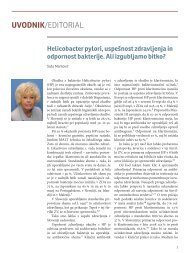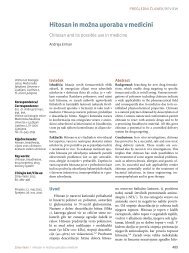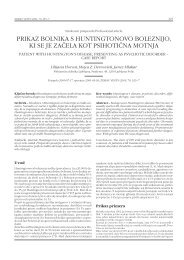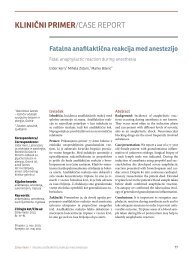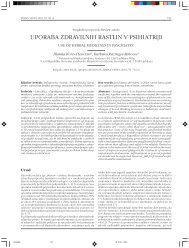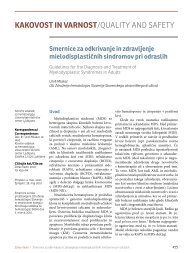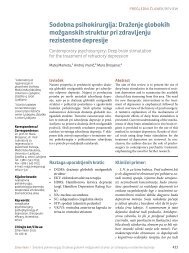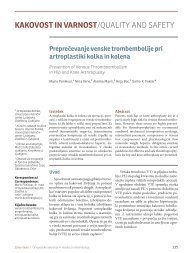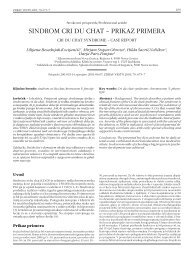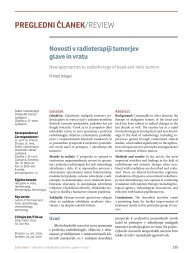Vpliv implantacije zarodkov na endometrij v lutealni fazi ciklusa
Vpliv implantacije zarodkov na endometrij v lutealni fazi ciklusa
Vpliv implantacije zarodkov na endometrij v lutealni fazi ciklusa
You also want an ePaper? Increase the reach of your titles
YUMPU automatically turns print PDFs into web optimized ePapers that Google loves.
I-102 Zdrav Vestn 2009; 78: SUPPL I<br />
stjo <strong>na</strong>domestimo z merjenjem debeline <strong>endometrij</strong>a ter njegove dolžine in širine, kar je<br />
možno opraviti <strong>na</strong> vsaki ultrazvočni <strong>na</strong>pravi. Kljub priporočljivim <strong>na</strong>daljnjim raziskavam<br />
menimo, da je mogoče <strong>na</strong>še ugotovitve koristno uporabiti v vsakodnevni klinični praksi,<br />
predvsem pri tehtanju, ali je nosečnost normal<strong>na</strong> ali ne, ter pri ugotavljanju nosečnosti v<br />
zgodnjem obdobju po morebitni zanositvi, še preden je mogoče potrditi prisotnost gestacijskega<br />
obročka.<br />
Ključne besede<br />
IVF; implantacija; <strong>endometrij</strong>; ultrazvok; 3D a<strong>na</strong>liza<br />
Abstract<br />
Background<br />
Methods<br />
Results<br />
Conclusions<br />
Key words<br />
Based on the facts known from embryology, rapid endometrial growth during late luteal<br />
phase of the cycle could be expected. In this research, we sought to establish if normal<br />
intrauterine preg<strong>na</strong>ncy could be confirmed before gestatio<strong>na</strong>l sac vizualization, by transvagi<strong>na</strong>l<br />
ultrasound and hormo<strong>na</strong>l tests. The primary hypothesis was that the endometrial<br />
thickness and/or volume in the luteal phase of the cycle, in cycles resulting in normal intrauterine<br />
preg<strong>na</strong>ncy, is significantly different compared to non-conception cycles. We also<br />
hypothesized that endometrial thickness and/or volume are different in cycles resulting<br />
in normal intrauterine preg<strong>na</strong>ncy compared to cycles resulting in abnormal preg<strong>na</strong>ncy,<br />
<strong>na</strong>mely biochemical and ectopic preg<strong>na</strong>ncy, and spontaneous abortion. Additio<strong>na</strong>lly, next<br />
to endometrial volumes, we decided to measure the endometrium in three planes (thickness,<br />
length and width), to see if the hypothesized endometrial volume differences could be<br />
approximated by this simple surrogate technique, which is available in most parts of the<br />
world.<br />
This was a prospective observatio<strong>na</strong>l study of women enrolled in an assisted reproduction<br />
program. Patients were stimulated with standard stimulation protocols. The oocyte retrieval<br />
was performed 36 hours after the hCG administration and the embryo was transferred 3 or<br />
5 days later. Patients were first seen on day 20–24 of the cycle , and then on day 27–30 of<br />
the cycle. A blood sample was taken, and 3D transvagi<strong>na</strong>l ultrasound was done. Following<br />
the completion of study visits, patients with a positive β HCG test received phone call checkups<br />
until week 12 of preg<strong>na</strong>ncy, and were stratified according to preg<strong>na</strong>ncy outcome.<br />
80 subjects signed the informed consent form. 4 patients had the IUI in the stimulated cycle,<br />
one had ET in spontaneous cycle, and 74 patients had undergone IVF/ET in the stimulated<br />
cycle. 63 patients in the stimulated cycles completed the study and are included in the statistical<br />
a<strong>na</strong>lysis presented here. Of these 63 patients, 36 (57.1 %) patients were preg<strong>na</strong>nt,<br />
and of these 36, nine (25 %) had abnormal preg<strong>na</strong>ncies that were a<strong>na</strong>lyzed separately. 27<br />
(42.8 %) patients were not preg<strong>na</strong>nt in the stimulated cycle. A significant difference was<br />
observed between Visit 1 and Visit 2, for endometrial volume, thickness, length and width in<br />
the preg<strong>na</strong>nt group, and for endometrial volume, thickness and width in the non-preg<strong>na</strong>nt<br />
group. Also, a significant difference was observed when comparing parameters at Visit 2<br />
between preg<strong>na</strong>nt and non-preg<strong>na</strong>nt patients.<br />
In this study we have shown that in normal intrauterine preg<strong>na</strong>ncy after an IVF/ET, a rapid<br />
and prominent endometrial volume growth can be detected by a 3D ultrasound over the<br />
course of several days. Moreover, in patients who did not conceive in a particular cycle, a<br />
minimal to moderate decrease in endometrial volume can be seen in all patients. We have<br />
also shown that the changes in endometrial volume can be approximated by measuring the<br />
changes in endometrial thickness, length and width, which can be done on every ultrasound<br />
machine. Although it warrants further investigation, we believe these findings may prove<br />
useful in everyday practice and when there is uncertainty as to whether the preg<strong>na</strong>ncy is<br />
normal or abnormal, and before gestatio<strong>na</strong>l sac visualization.<br />
IVF; implantation; endometrium; ultrasound; 3D<br />
Literatura<br />
1. Alcazar JL. Three-dimensio<strong>na</strong>l ultrasound assessment of endometrial receptivity: a review. Reprod Biol Endocrinol 2006; 4: 56.<br />
2. Bassil S. Changes in endometrial thickness, width, length and pattern in predicting preg<strong>na</strong>ncy outcome during ovarian stimulation in<br />
in vitro fertilization. Ultrasound in Obstetrics and Gynecology 2001; 18: 258–63.



